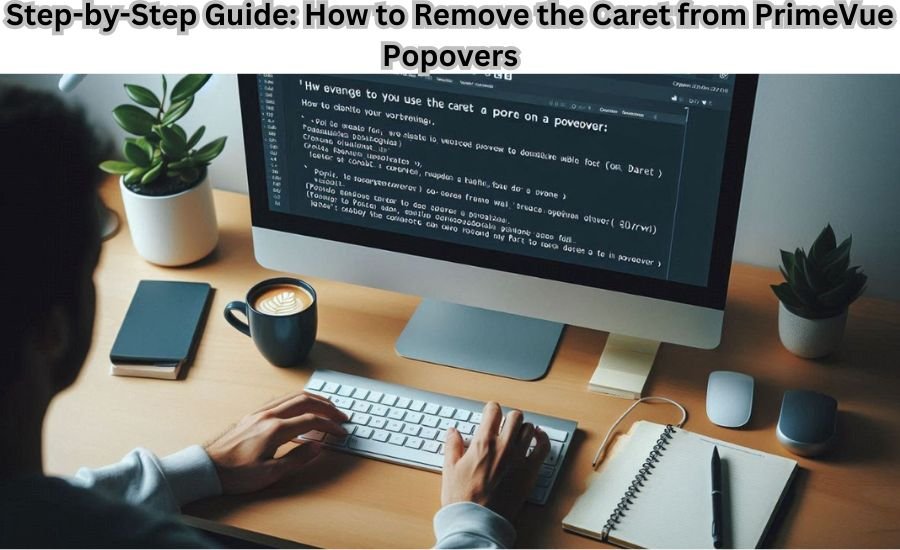When designing a user interface with PrimeVue, you may encounter a small but notable issue: the caret on popovers. If you want to get rid of caret on popover PrimeVue, you’re not alone! Many developers seek to refine their designs, opting for a cleaner and more modern aesthetic. This guide will explore why removing the caret can elevate your web application’s look while ensuring your users enjoy a seamless experience.
The caret, often seen as a directional arrow, serves to indicate where the popover originates. However, it can sometimes clash with the overall design, drawing attention away from the content that truly matters. In this blog post, we will discuss practical techniques to get rid of caret on popover PrimeVue, helping you achieve a polished and distraction-free user interface.
Understanding the Caret: The Functionality Behind Popovers in PrimeVue
get rid of caret on popover primevue are helpful tools that provide additional information. They usually have a small arrow called a caret. This caret points to the element that opened the popover. It helps users understand where the popover is coming from. However, sometimes, the caret can clash with your design. This can distract users from the content in the popover.
Knowing the role of the caret is important for designers. While it serves a purpose, not every design needs it. For instance, in minimalist designs, the caret may seem out of place. Therefore, many developers are eager to find ways to get rid of the caret on popover PrimeVue.
Why You Should Get Rid of Caret on Popover PrimeVue: Benefits for Your UI
There are several good reasons to remove the caret from your PrimeVue popovers. First, it can give your UI a cleaner look. Without the caret, your popover appears more modern and sleek. This can help create a more professional feel for your application.
Another reason is to improve user focus. When users see a popover, they should pay attention to the information inside it. If the caret is distracting, it might take away from the content. By eliminating this visual distraction, users can concentrate better on what you want them to see.
Lastly, removing the caret can make your design more consistent. If other elements in your application do not have carets, it is wise to keep things uniform. This consistency helps create a more harmonious user experience.
Step-by-Step Guide: How to Remove the Caret from PrimeVue Popovers

Removing the caret from PrimeVue popovers is not difficult. The first method is to change the CSS. By adding a few lines of code, you can easily hide the caret. Here’s how:
css
Copy code
.popover::before {
display: none;
}
This CSS rule hides the caret completely. It ensures your UI remains clean while keeping the popover’s main functionality intact.
Another way to remove the caret is by overriding component styles. You can target the caret class specifically. Use this CSS code:
css
Copy code
.prime-popover-caret {
visibility: hidden;
}
This approach will remove the caret from all popovers globally, ensuring a uniform style across your project.
You May Also Like: Dariaeteri
Common Issues When Removing the Caret and How to Solve Them
Even though removing the caret is easy, you might face some challenges. One common issue is the caret reappearing. This can happen if your CSS is not specific enough. To solve this, ensure your CSS selectors are strong enough to cover all popover instances.
Sometimes, hiding the caret may affect the popover’s spacing. If you notice layout problems, adjust the margins or padding of the popover. This small tweak can help maintain a good look without the caret.
Lastly, be aware of cross-browser compatibility. CSS can look different on various browsers. Test your changes in popular browsers like Chrome and Firefox to ensure everything looks right. By tackling these issues, you can successfully get rid of the caret on popover PrimeVue without compromising your design.
CSS Solutions: Hiding the Caret Effortlessly
Hiding the caret in PrimeVue popovers can be easily achieved with a few simple lines of CSS. The caret is typically added as a pseudo-element, making it accessible for customization. To remove it effectively, you can target the caret using the ::before selector. Here’s a straightforward example of how to do this:
css
Copy code
.popover::before {
display: none;
}
This CSS rule will hide the caret entirely, ensuring a clean and distraction-free user interface. It’s a quick fix that requires minimal effort but yields significant visual benefits. This solution allows you to maintain the popover’s functionality while achieving a more modern and minimalist design.
In addition to the display: none; rule, you can also use other CSS properties to adjust the appearance of your popover. For instance, if you want to keep the caret but make it less prominent, you can adjust its opacity or size. Here’s an example:
css
Copy code
.popover::before {
opacity: 0.5; /* Makes the caret semi-transparent */
width: 10px; /* Adjusts the width of the caret */
height: 5px; /* Adjusts the height of the caret */
}
By implementing these CSS techniques, you can effectively control the visibility and appearance of the caret, tailoring it to fit your design vision.
JavaScript Techniques: Dynamically Disabling the Caret
For developers who prefer a more dynamic approach, using JavaScript to control the visibility of the caret can be a powerful technique. This method allows you to remove the caret based on user interactions or specific conditions in your application. By manipulating the popover properties through JavaScript, you can create a more interactive user experience.
Here’s an example of how you can achieve this:
javascript
Copy code
const popover = this.$refs.popover; // Accessing the popover reference
popover.caret = false; // Dynamically disables the caret
In this code snippet, we access the popover instance and set the caret property to false. This way, the caret will not be displayed when the popover is triggered. It’s a great option if you want to control when the caret appears based on certain user actions.
You can also create conditions for the caret’s visibility. For example, if you only want to hide the caret in certain scenarios, you can use conditional logic like this:
javascript
Copy code
if (someCondition) {
popover.caret = false; // Hide the caret
} else {
popover.caret = true; // Show the caret
}
Using JavaScript gives you flexibility in managing the caret, allowing you to enhance the user experience by showing or hiding it based on the context.
Enhancing User Experience: The Impact of a Caret-Free Popover
Removing the caret from PrimeVue popovers can significantly enhance the user experience. When users interact with a popover, their focus should be on the information presented rather than the surrounding design elements. A cleaner interface, free of unnecessary distractions, allows users to engage more effectively with the content.
By eliminating the caret, you can create a modern look that aligns with current design trends. This minimalistic approach fosters a more professional appearance, making your application stand out. Users appreciate designs that prioritize functionality and clarity, leading to a more satisfying experience overall.
Moreover, a caret-free popover can improve accessibility. Users with visual impairments may find distractions in design elements overwhelming. By simplifying the UI, you can help ensure that all users, regardless of their abilities, can easily navigate your application and absorb the information presented.
In addition, a seamless user experience can lead to increased user retention. When users feel comfortable and focused, they are more likely to return to your application. A positive interaction with your interface can build trust and loyalty, which is essential for the long-term success of any application.
Design Consistency: Maintaining a Cohesive Look Across Your Application

Consistency in design is vital for creating a cohesive user experience. When all elements of your application, including popovers, align visually, it helps users navigate more easily. Removing the caret can be a step towards achieving that consistency.
If other components of your application do not feature carets, it makes sense to remove them from your popovers as well. This uniformity ensures that users are not distracted by varying design elements. A cohesive look enhances usability, allowing users to focus on content rather than the differences in design.
To maintain design consistency, consider establishing a style guide for your application. This guide can outline color schemes, typography, and component styles, including popovers. By adhering to this guide, you can ensure that all elements of your application work harmoniously together, reinforcing your brand identity.
Additionally, regular design audits can help identify areas where consistency may be lacking. Reviewing your application periodically ensures that all components remain aligned with your design goals. This proactive approach to design consistency can lead to a better overall user experience.
Conclusion
Removing the caret from PrimeVue popovers is a smart choice for many developers. It enhances the visual appeal and allows users to focus on the important content. With simple CSS adjustments or JavaScript techniques, you can create a cleaner and more modern interface.
Now that you know how to get rid of the caret on popover PrimeVue, you can confidently refine your designs. This small change can significantly impact your application, leading to a more polished user experience. A seamless interface not only pleases the eye but also promotes usability, making your website a favorite among users.
Embracing a sleek design will help you create applications that stand out in a competitive market. As you implement these changes, you can look forward to a more user-friendly experience, ultimately enhancing satisfaction and engagement.
Get the Latest Updates On Knowlegdera
FAQs
Q: What is the purpose of the caret in PrimeVue popovers?
A: The caret in PrimeVue popovers serves as a visual indicator, pointing to the element that triggered the popover. It helps users understand the popover’s origin.
Q: Can removing the caret affect the functionality of the popover?
A: No, removing the caret does not impact the functionality of the popover. The core features remain intact, and only the visual presentation changes.
Q: How can I hide the caret on popovers using CSS?
A: You can hide the caret by adding the following CSS rule: .popover::before { display: none; }. This will effectively remove the caret from the popover.
Q: Is it possible to remove the caret dynamically using JavaScript?
A: Yes, you can remove the caret dynamically by setting the popover.caret property to false in your JavaScript code, allowing for conditional visibility based on user interactions.
Q: What should I do if the caret reappears after I’ve hidden it?
A: If the caret reappears, ensure your CSS selectors are specific enough to override any conflicting styles. You may need to adjust your CSS rules to ensure they apply to all instances of the popover.
